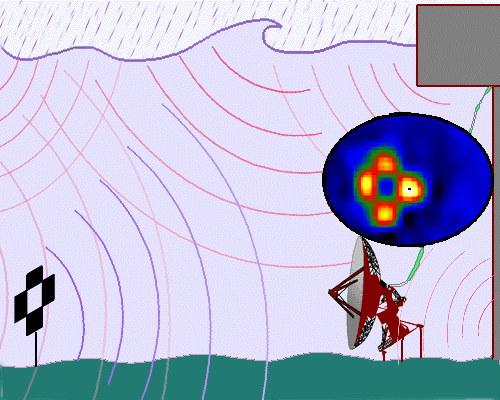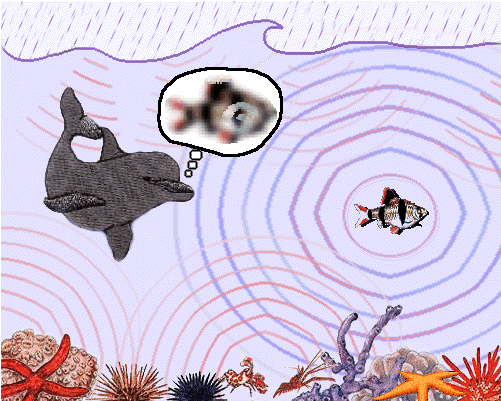John R. Potter, johnp@arl.nus.edu.sg
Acoustic Research Laboratory, http://www.arl.nus.edu.sg
Elec. Eng. Dept.
NUS, 10 Kent Ridge Crescent
Singapore 119260.
Elizabeth Taylor, mdcohe@leonis.nus.sg
Tropical Marine Science Initiative
NUS, 10 Kent Ridge
Crescent, Singapore 119260
Mandar Chitre, mandar@arl.nus.edu.sg
Acoustic Research Laboratory
Elec. Eng. Dept.
NUS, 10 Kent
Ridge Crescent, Singapore 119260.
Popular version of paper 2pAO7
Presented Tuesday afternoon, December 2,1997
134th ASA Meeting, San Diego, CA
Embargoed until December 2 1997
Ambient Noise Imaging (ANI) is a new concept in seeing underwater with sound, quite different from active and passive systems which have existed in biological contexts for perhaps millions of years, and in workable man-made versions for less than a century. Active systems rely on hearing the echoes from sound injected into the environment. Dolphin and bat echolocation are biological examples, while the classic 'ASDIC' anti-submarine warfare system of WWII is a more recent and relatively primitive man-made version. Passive systems make no sound, but detect noisy objects by the sound they radiate. Our hearing is perhaps the most familiar example, and all submarines are equipped with expensive passive systems to locate other vessels while remaining quiet and hidden.
Ambient Noise Imaging (ANI) is entirely new, at least to people. The idea was first clearly articulated by Prof. Michael Buckingham about 10 years ago, leading to a pilot experiment proving the elements of the concept, published in Nature [1]. Prof. Buckingham and Dr. Potter proceeded to develop the next step, a real-time ANI camera, which was successfully deployed in 1993, and reported in Scientific American last year [2].

The Ambient Noise Imaging (ANI) principle was successfully demonstrated using the first ANI camera to be built, the Acoustic Daylight Ocean Noise Imaging System (ADONIS) in 1994. This sketch shows ADONIS (right) looking at a target made from 1m x 1m square panels at 40m range (not to scale). The sound sources which illuminated the target panels were primarily small crustaceans on the sea bed and nearby structures. The actual image obtained from ANI processing is shown inserted above ADONIS.
Dr Taylor then thought it a logical progression to ask whether marine mammals might already be using this newly invented ANI technique as part of their sensory arsenal. The toothed whales (Odontecetes), for example, might find advantage in not broadcasting their imminent presence while in pursuit of an intelligent prey. Nature has a habit of optimising sensory systems and we were far behind animals in discovering active sonar. Perhaps ANI is another example of how we can learn from nature. Indeed, is ANI a basic sensory technique upon which marine mammals rely to 'see' underwater? If so, this has significant implications for our understanding of these animals and their behaviour, particularly in the wild. It may help explain why so many dolphins continue to become entangled by drift nets, for example, which their echolocation sonar should easily be able to detect. There are some documented events which lend circumstantial support to the proposition. One report recounts how investigators applied eye cups to an Atlantic bottlenose dolphin (Tursiops truncatus) and then threw a live fish into the pool, this exercise being a casual and unplanned sequel to a more rigorous and traditional echolocation experiment. The dolphin, who had never encountered a live fish in its several years of captivity, followed and caught the fish 5 times in 5 sequential tests without any sound being recorded either by the listening devices secured to the dolphin's head or by others suspended at various locations in the pool. A similar report exists for the grey seal (Halichoerus) tested with an air-filled plastic ring as a target. In an attempt to explain these observations we have explored the possibility that these animals might use a biological sense equivalent to ANI when their target is a good resonator, such as a fish with a swim bladder. One can imagine that there would be significant advantages for a marine mammal not to advertise its proximity to its prey by using active sonar to locate the target object, particularly since it is known that dolphin echolocation clicks tend to alarm fish.

Might a dolphin also use ANI techniques to 'see' potential prey? The ocean is rich with suitable natural sound sources, from biological origins such as fish and snapping shrimp, to 'singing bubbles' formed by rainfall or breaking waves at the sea surface.
With today's powerful computers, we are
able as never before to simulate
complicated acoustic environments and the
interaction of sound with objects
at high frequencies and short ranges. We
have written a custom program to
simulate the acoustic 'soundscape' for
some typical environments, included
realistic interaction of sound with a
potential prey fish, and calculated
(using a model based on many years of
research in dolphin hearing) what
a dolphin might be able to detect. With
the two classic forms of sonar,
active and passive, marine mammal biosonar
has always outperformed man-made
sonar of comparable dimensions. Our model,
which does not include sophisticated
signal processing to enhance results,
therefore represents a lower bound
to the quality of image that a dolphin
might obtain. And yet, we find that
the known acoustic abilities of
dolphins do predict that useful images can
be obtained for tens of metres
in typical scenarios, farther than one can
normally see underwater. The
conceptual impact of this realisation should
not be underestimated. One
direct practicable outcome is that this knowledge
should enable us to
design better ways of warning marine mammals that use
ANI of potentially
dangerous obstacles in their environment, such as fishing
nets. It seems
that dolphins, and perhaps other animals, have a whole new
way of seeing
with sound that has not been
suspected.
[1] Buckingham, M.J., B.V. Berkhout & S.A.L. Glegg, 1992. "Imaging the ocean with ambient noise", Nature 356, 327-329.
[2] Buckingham, M.J., J.R. Potter & C.L. Epifanio. 1996. "Seeing in the ocean with background noise", Scientific American., 274(2), 86-90.
Hotel contact numbers for J. Potter during meeting: Tel: (619) 298-0511 Fax: (619) 298-9793
Office Telephone number in Singapore: (+65) 874 2129
Office Fax number in Singapore: (+65) 779 1103